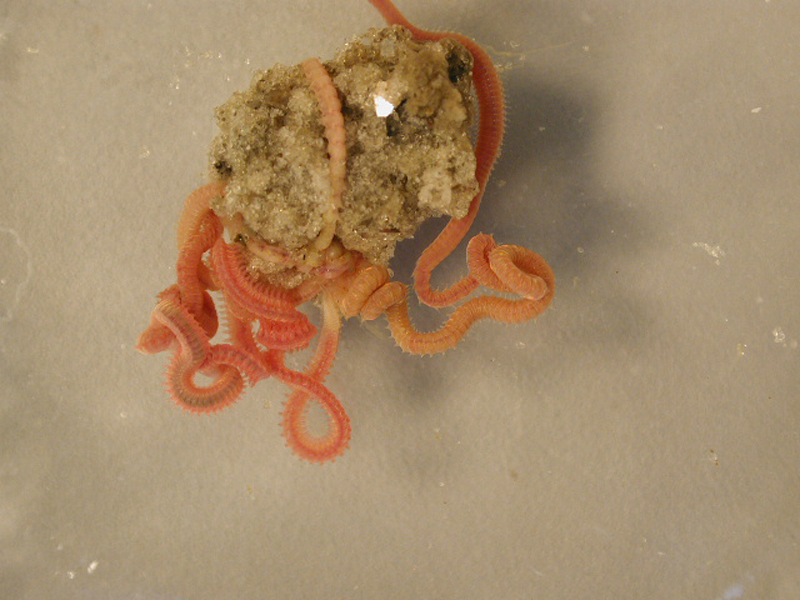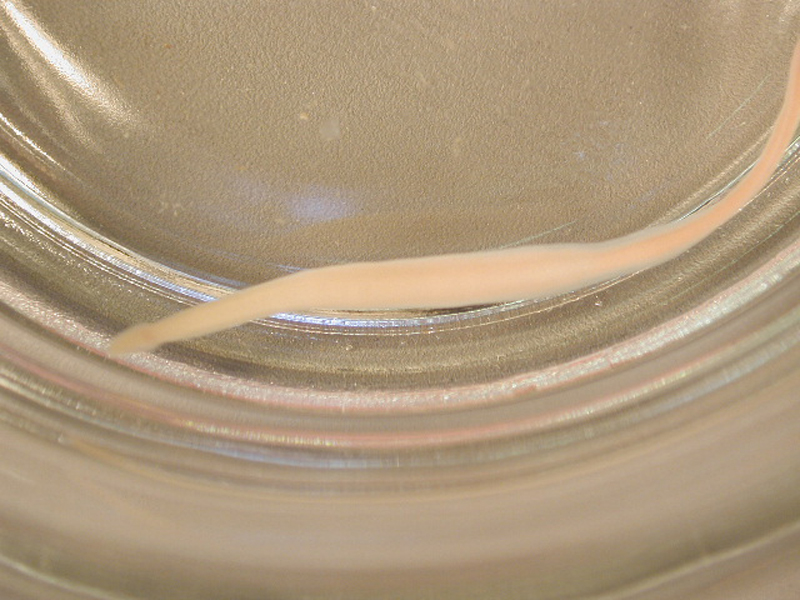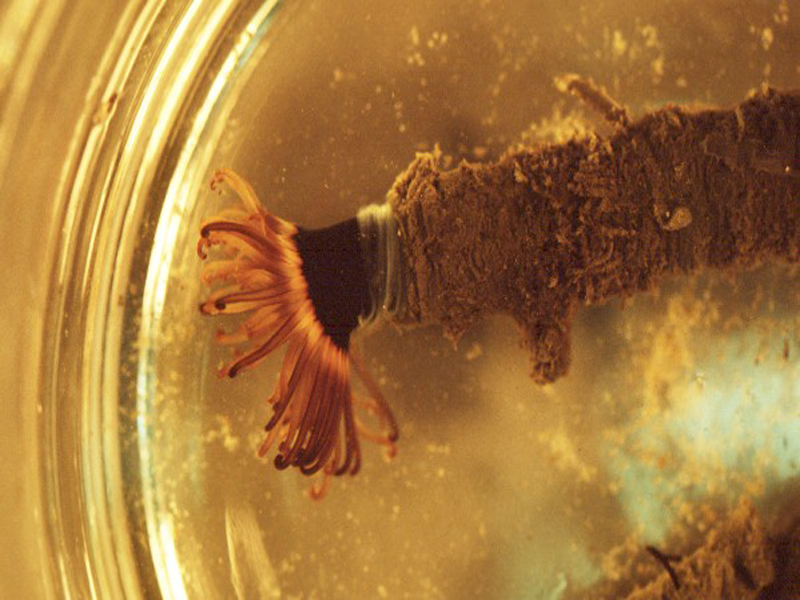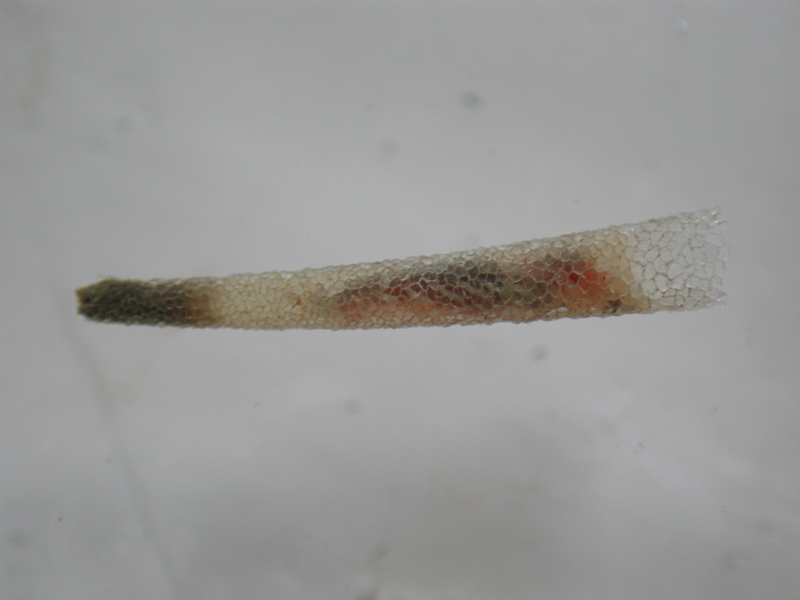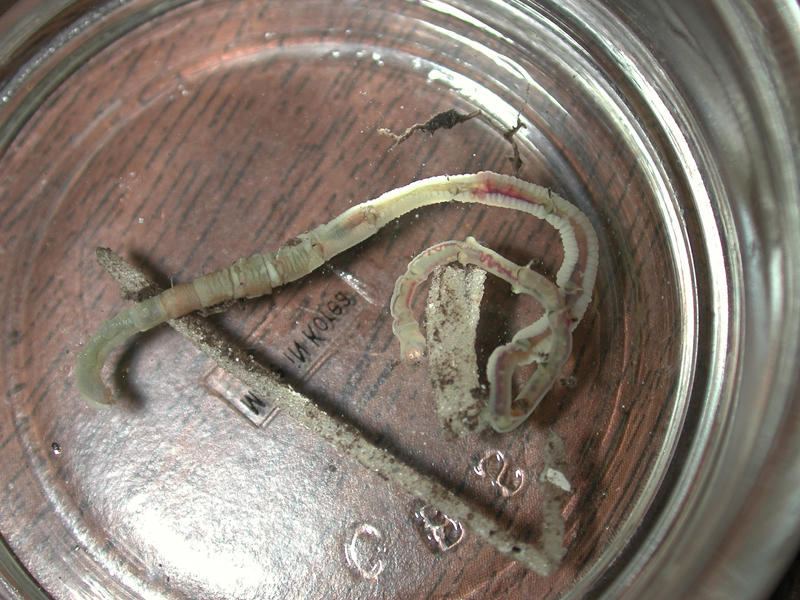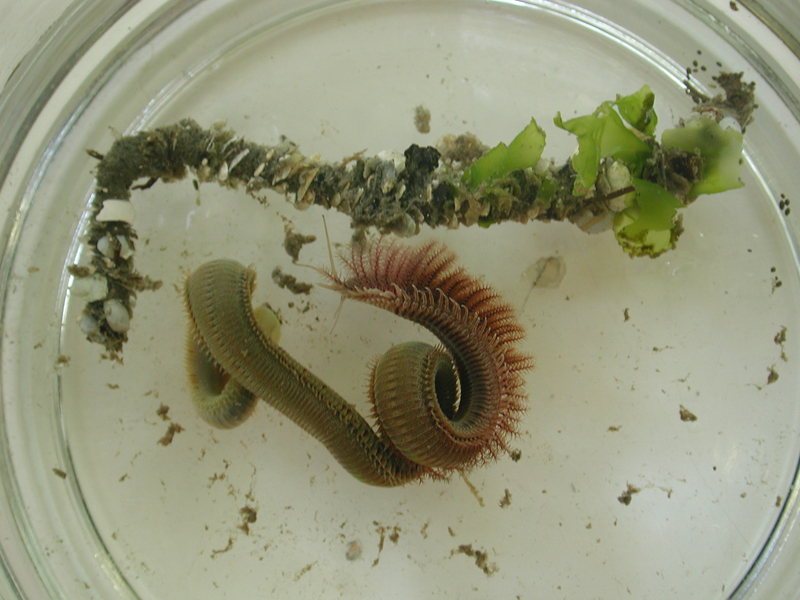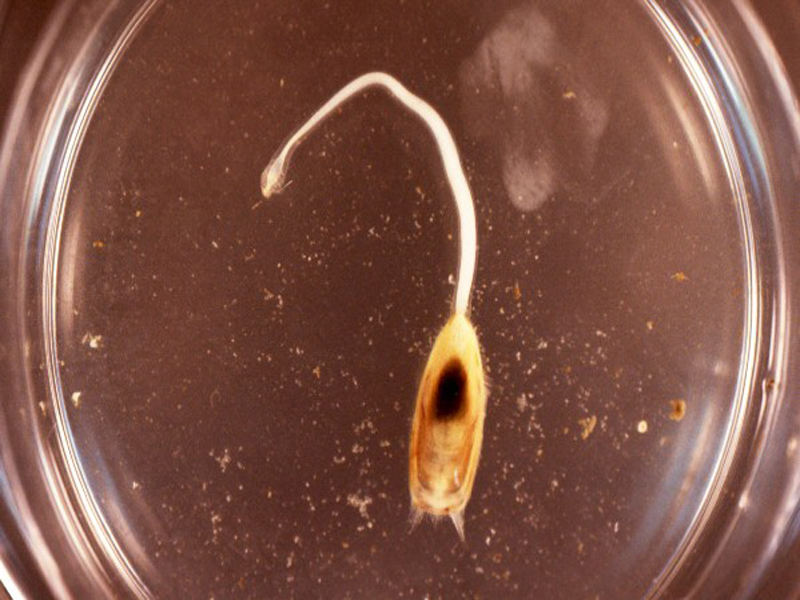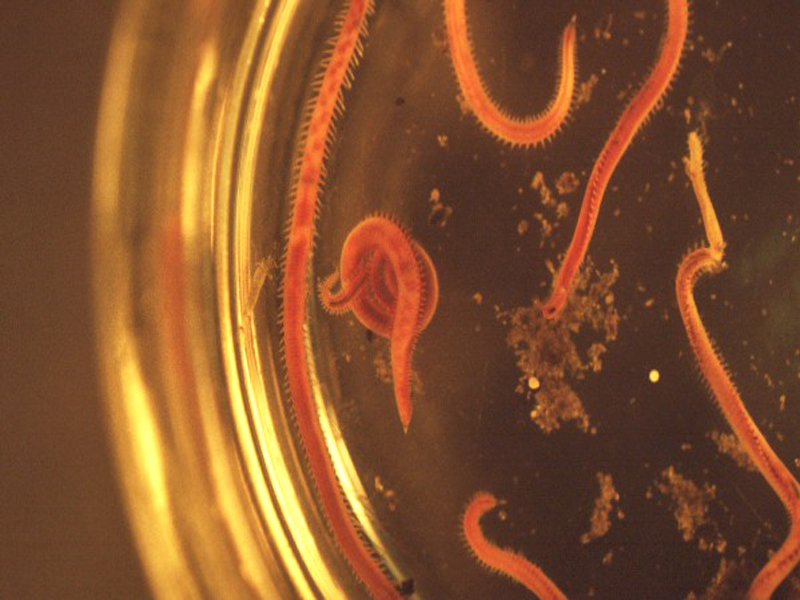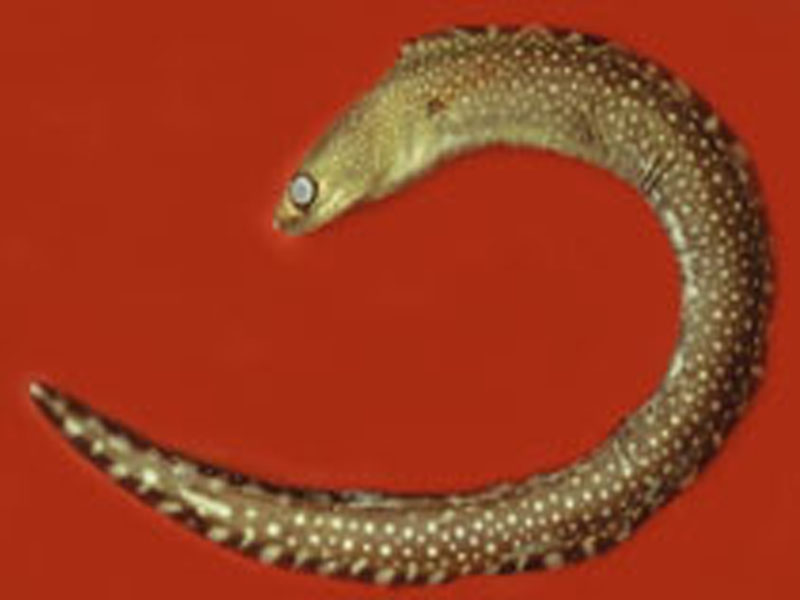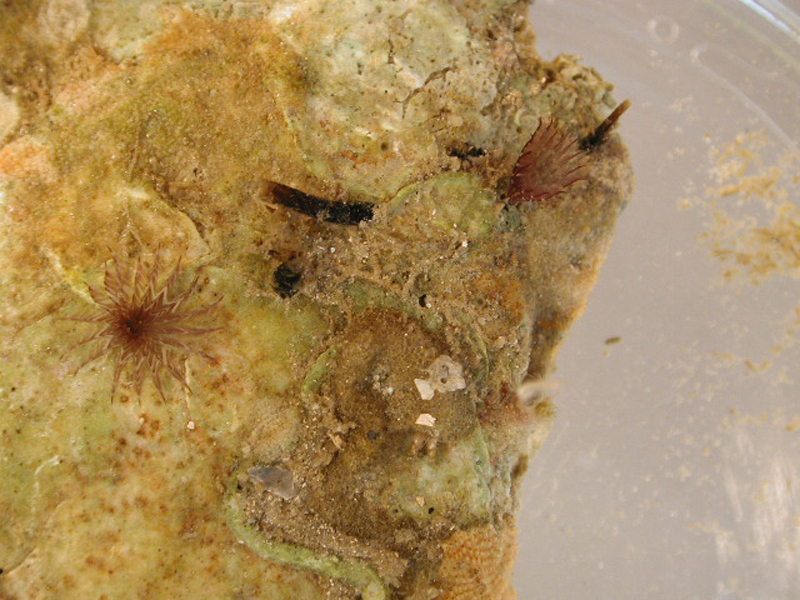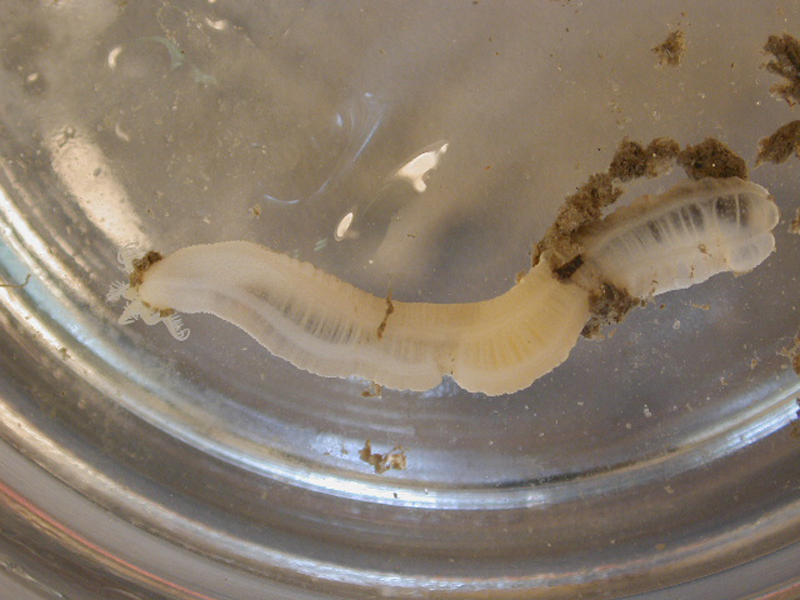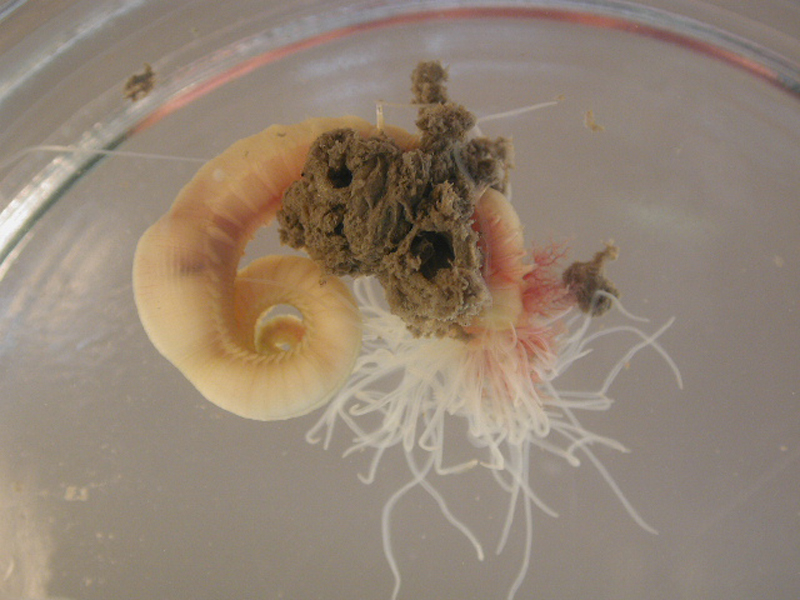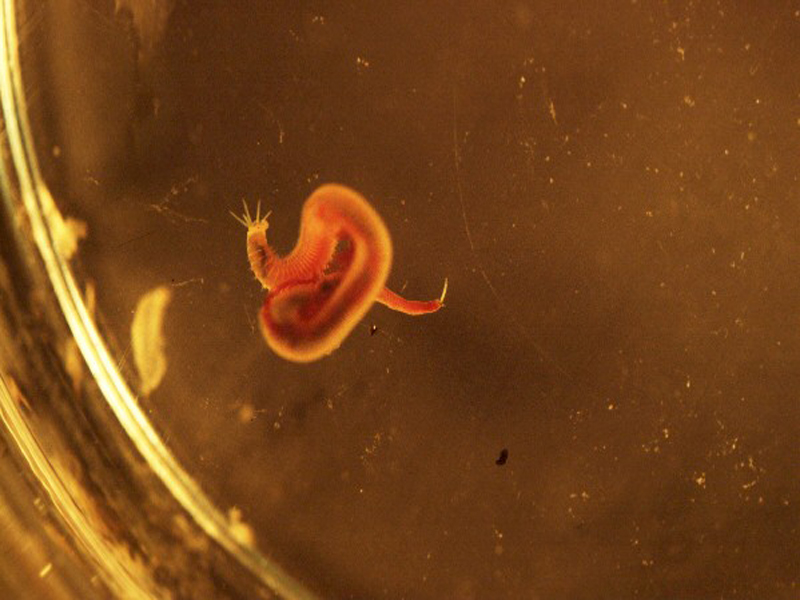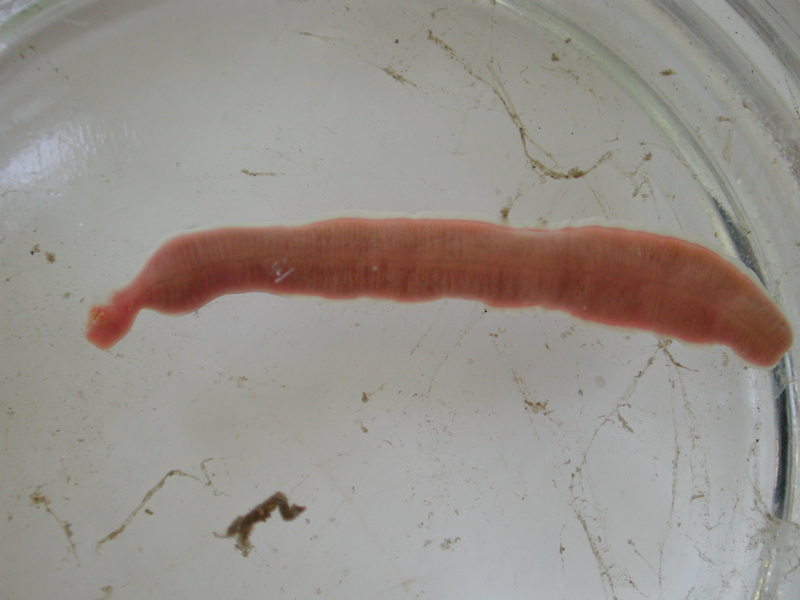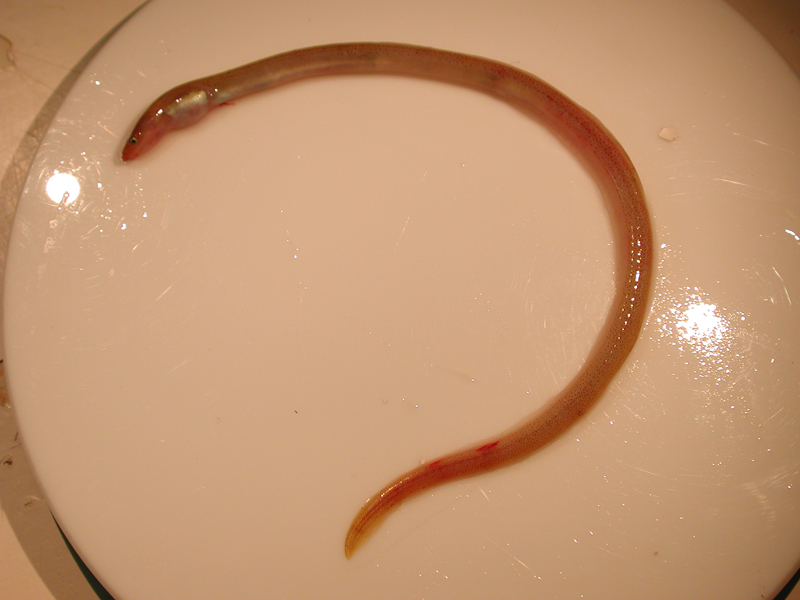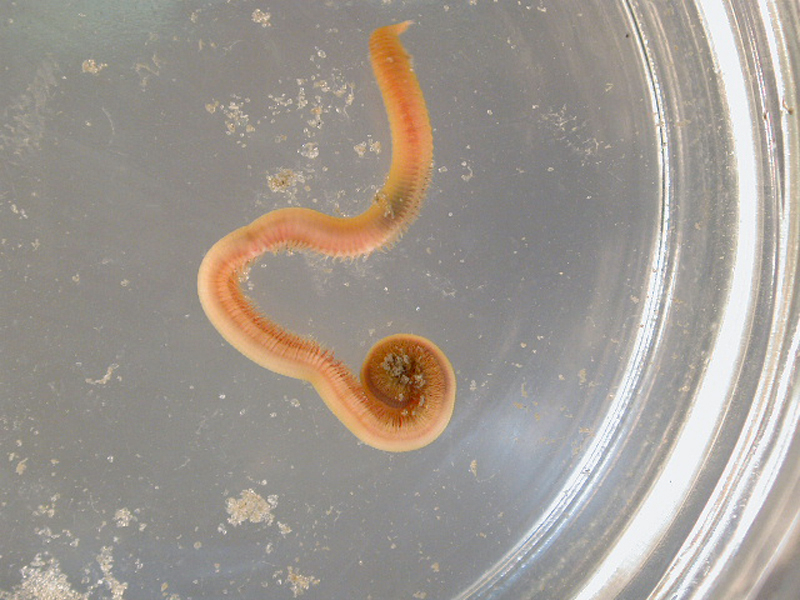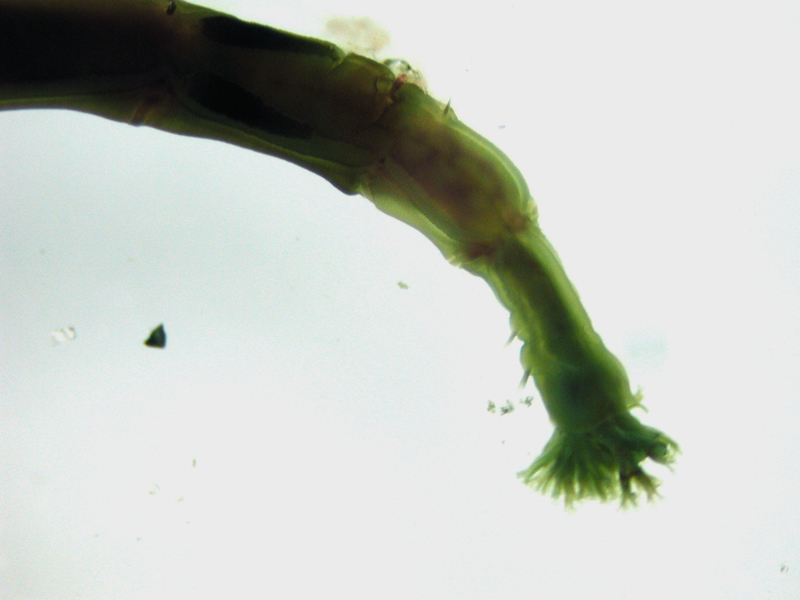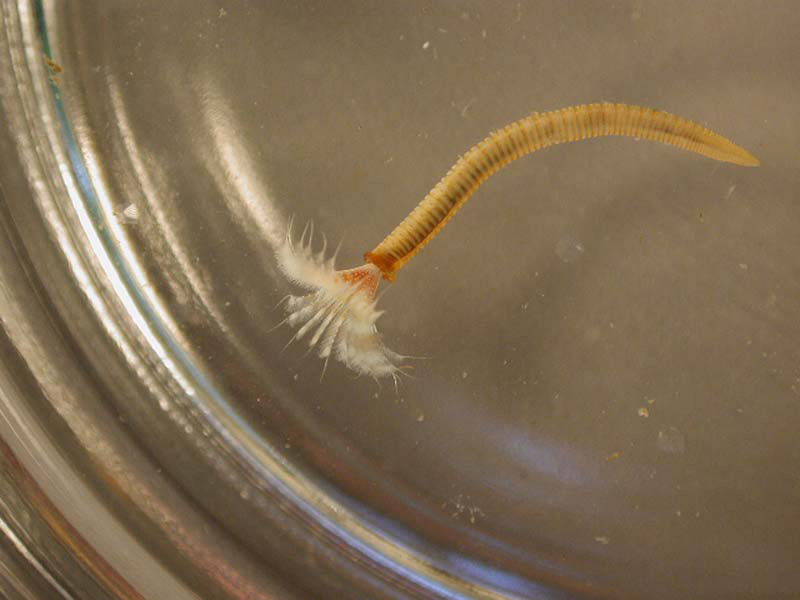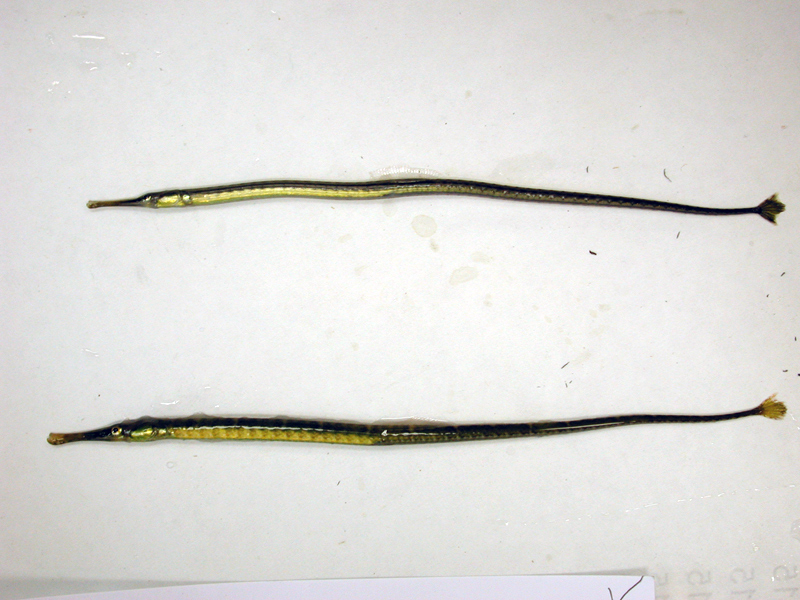Worm-like
Opalworm
Description
The opalworm burrows in sand and sandy mud, in oyster beds, and among eelgrass roots, usually in estuaries with low salinities from the low tide line to deep waters. This long, slender, cylindrical worm appears reddish-brown, reddish-yellow, or greenish with a brilliant metallic iridescence. It possesses 500 segments and lacks any visible appendages, resembling a slender earthworm. Its proboscis (snout) is eversible and armed with strong jaws to help break down the bodies of its prey. The opalworm reaches a length of 2 feet and a width of ¼ inch.
What Are The Effects On Clams?
Opalworms are predators of other worms, and can consume worms that could foul or encrust clams and clam bags. In addition, their burying actions can aerate the sediments, improving the quality of the lease bottom
- FRIEND
What Can A Clam Farmer Do?
No action needs to be taken by a clam farmer. Be wary though, a 2 foot specimen could give a clam farmer quite a nip on the finger.
Milky Ribbon Worm
Description
The milky ribbon worm burrows in sand or sandy mud, under rocks, in sheltered bays and estuaries, near the low-tide line and below. This worm varies in color from milky white, yellowish or pinkish in young forms to mature males being red and females being brownish. They also vary in shape over the length of the body being cylindrical and firm at the tail, wide and flat over most of the length of the body, and having a head shaped like a spearhead. There are deep sensory grooves on the head, no eyespots, and the mouth is an elongate slit. The milky ribbon worm is by far the largest ribbon worm on the Atlantic Coast, reaching a length of 4 feet and a width of 5/8 inch.
What Are The Effects On Clams?
The ribbon worm is known to prey on softer shell clams, but may consume smaller hard clams, particularly seed (Woods Hole Sea Grant, 2005). It injects its tooth-like proboscis (snout) into its prey and digests the clam in its shell. Gaped, open, clam shells are left with no signs of forced entry, but often meat is left in the shells.
- FOE
- Predator
What Can A Clam Farmer Do?
The ribbon worm is not found in numbers high enough to cause problems for clam farmers. No practical control method exists.
American Tube Dwelling Anemone
Description
The American tube dwelling anemone occupies muddy sand flats. This anemone inhabits a tough, silky tube that is made of tangled threads. The tube may be colonized by fouling organisms. The animal has two distinct whorls of tentacles and can withdraw into the tube. They feed by spreading the tentacles on the surface of the sand to gather food particles. Tubes may reach 20 inches in length and about 1 ½ inches in diameter.
What Are The Effects On Clams?
The tube dwelling anemone coexists in the clam lease environment and clam bag, with no known effects to clams.
- NEIGHBOR
What Can A Clam Farmer Do?
No action needs to be taken by a clam farmer.
Parchment Tube Worm
Description
The parchment worm is found buried in mud, sandy mudflats and eelgrass beds in protected bays and estuaries, from near the low-tide line to water 25 feet deep. The whitish-tan “U”-shaped tube of this worm is distinctive enough to identify it. The tube is wide enough to accommodate the worm along most of its length. Each end of the tube rises 1-2 inches above the surface of sandy mud flats and tapers, encasing the worm within. The body of this translucent, flesh-colored worm is divided into three sections. The front end has a shovel-shaped head with a pair of short tentacles. Pairs of wing-like and cup-shaped appendages spread a mucus net across the tube to catch plankton and detritus. Periodically, mucus and food are rolled into a ball and passed up the food groove to the head and mouth. The middle section has prominent "fans" used to propel water through the tube. The rear section has 30 segments, each loaded with sperm or eggs in ripe adults. The worm can reach a width of 1 inch and a length of 10 inches, with its tube extending up to 24 inches.
What Are The Effects On Clams?
Parchment worms are filter or suspension feeders and, therefore, can compete for the same type of food (micro algae) as clams.
- FOE
- Competitor
What Can A Clam Farmer Do?
Parchment worms are infrequently found in clam bags and rarely pose a problem.
Ice Cream Cone Worm
Description
The ice cream cone worm occurs on protected beaches along Florida’s coast. The animal builds a tube of sand grains which are perfectly fitted together. As the animal grows, it adds sand grains at the wide end of the tube. The completed tube is fragile but rigid, and resembles an ice cream cone. Tubes are oriented vertically in sand, with the wide head end down. The worm feeds on particles of organic material with stout, golden bristles and tentacles. Ice cream cone worms reach 2 inches in length.
What Are The Effects On Clams?
Since the ice cream worm constructs tubes, it can foul or encrust clams and clam bags.
- FOE
- Fouler
What Can A Clam Farmer Do?
The tubes of the ice cream worm are fragile and can be easily rinsed off the clam shell.
Bamboo Worm
Description
The bamboo worm gets its name due to the conspicuous segmentations making it appear similar to a bamboo stem. They live in straight tubes composed of sand or mud in intertidal flats, and orient with their heads down, feeding on organic matter and sediment while defecating through its upper end onto the surface of the sand. The worm is about 4 inches long, while the fragile tube is up to 8 inches long, and is a green-brown to reddish color. It has a crown-like segment at its tail and, since the head is deep in the sand away from the oxygenated water, it contracts its body to pump water into its tube down to the head. The bamboo worm often shares its tube with symbiotic clams and amphipods.
What Are The Effects On Clams?
Since the bamboo worm constructs tubes, it can foul or encrust clams and clam bags.
- FOE
- Fouler
What Can A Clam Farmer Do?
The tubes of the bamboo worm are fragile and can be easily rinsed or brushed off clam shells and bags.
Plumed worm, Decorator Tube Worm
Description
The plumed worm is a fairly large worm, up to 12 inches long, and is a common polychaete of Atlantic and Gulf of Mexico intertidal mud flats. Often, their presence is noted by the shaggy, debris-covered tubes projecting above the mud, extending up to 4 feet below. The tube is formed by a secretion of the worm, and it physical attaches shell fragments, algae, plant fibers and debris to the top of it, encouraging seaweeds and small creatures to colonize, upon which the worm feeds. The worm is a greenish color with 5 long tentacles at the head. It uses body undulations to pump water to its 30-40 pairs of bright red gill filaments on the upper half of the body. It is occasionally seen creeping out of its tube to search for food or tube-building material.
What Are The Effects On Clams?
Tube worms are not always a problem, but at some lease areas and in some years (usually when salinity levels are high), there are excessive outbreaks that can result in large losses of clams. Nursery bags are particularly vulnerable as tube worms can create thick encrusting mats, limiting water exchange through the small mesh openings and resulting in clam suffocation. The worms can also bind the top and bottom of a newly planted bag together, reducing the growing area for clam seed.
- FOE
- Fouler
What Can A Clam Farmer Do?
During those times when tube worms are abundant, it is prudent for a clam farmer to take action. Placing large mesh, polyethylene cover netting over nursery bags may help. But it is critical that the farmer removes the netting, thus removing the tube worms, in a timely manner. A new layer of cover netting can then be replaced over the bags. While air exposure of 24-48 hours is effective in removing the worms, this treatment is not necessarily practical, and is certainly labor intensive as it requires a farmer to pull nursery bags out of the lease bottom. However, restocking clam seed into clean nursery bags and replanting may save the crop.
Lamp Shell
Description
The lamp shell is found on sandy mudflats from the low-tide line to waters over 500 feet in depth. The tongue-shaped shell of this brachiopod is white with green cross-bands. The edges of the shell are bristly. The stalk of the animal emerges between the rear end of its shells. Double-coiled tentacular arms protrude from the shells while feeding. It can be located by its slit-like hole in the surface of a mudflat. At low tide, it lies in its burrow; while at high tide, the tips of its shells rise above the surface. The shell of the lamp shell is 1 3/8 inch long and ½ inch wide, while the stalk reaches 1¾ inch long and 1/8 inch wide.
What Are The Effects On Clams?
The lamp shell is a filter or suspension feeder and, therefore, can compete for the same type of food (micro algae) as clams.
- FOE
- Competitor
What Can A Clam Farmer Do?
Lamp shells are found in relatively low numbers in clam bags and should not pose a problem.
Blood Worm
Description
The blood worm is a very common worm found all along the Atlantic and Gulf of Mexico coasts. It can reach 20 inches long, and burrows into intertidal mud flats searching for its prey of small crustaceans and other worms. Unlike most worms, the blood worm is not segmented internally, thus when pierced with a fish hook, for example, it bleeds copiously. The worm is tapered at both ends, and swims with erratic snake-like movements. To burrow, they explosively evert their proboscis (snout) into the sand, then it swells, anchors into the sand, and contraction brings in the rest of the body. That same explosive proboscis is used to catch their prey. The end is equipped with four poisonous, curved jaws that pierce the animal. If picked up, the action of the proboscis and the red blood are clearly visible through the white-pinkish body. Caution should be used, however, as they are known to pierce human skin with their jaws
What Are The Effects On Clams?
Blood worms are predators of other worms, and will consume worms that foul or encrust clams and clam bags. In addition, their burying actions aerate the sediments, improving the quality of the lease bottom
- FRIEND
What Can A Clam Farmer Do?
No action needs to be taken by a clam farmer.
Ocellated Moray
Description
The ocellated moray is a solitary species often found on deep soft bottom areas and banks 3-300 feet deep, in seagrass beds in estuaries and lagoons, but rarely on coral reefs. They are robust, heavy-bodied eels with the caudal (tail) fin joined to the dorsal (top) and anal (bottom) fins, but have no pectoral (shoulder) fins. Most morays have small, rounded gill openings on the sides of the head. They are brown on top with regularly-spaced large, black ocellated (eye-like) spots along the edge of the dorsal fin. The underside is pale with many pale spots creating a net-like pattern. This moray has distinct blackish lines in the gill region. The top of the head is broad and flattened with dark and pale spots. The ocellated moray reaches a length of 2 feet. Moray eels have the worst reputation of all the eels because of the vicious nature attributed to the larger members of the family.
What Are The Effects On Clams?
The ocellated moray occurs infrequently in the clam lease environment and clam bag, with no known effects to clams. However, it can bite a clam farmer.
- NEIGHBOR
What Can A Clam Farmer Do?
No action needs to be taken by a clam farmer.
Feather Duster Worm
Description
The feather duster worm is found attached to hard objects, such as shells and rocks, from the low-tide line to water 50 feet in depth. This species has a white calcareous tube which is rough and often irregularly coiled. The tubes may be solitary or occur in tangled masses. Its body is yellowish or greenish in color, and orange plumes, or gills, fan out on either side of the tube. When the worm withdraws into its tube, opercular spines expand out into a circle of dagger-like projections, protecting the tube entrance. The feather duster worm can grow to a length of 1½ inches.
What Are The Effects On Clams?
The feather duster worm constructs tubes, but does not set on smooth surfaces. It will only be found attached to other fouling organisms on the clam or bag. Feather duster worms are filter or suspension feeders and, therefore, can compete for the same type of food (micro algae) as clams.
- FOE
- Competitor
- Fouler
What Can A Clam Farmer Do?
Feather duster worms are infrequently found in clam bags and rarely pose a problem.
White Synapta
Description
The white synapta prefers sandy and muddy sediments in depths less than 3 feet, and sometimes is found in association with seagrasses. The body of this worm-like sea cucumber is fragile, smooth and translucent white, allowing the internal organs to show through. Five white longitudinal muscle bands are visible through the body wall. No tube feet are present; rather a series of calcareous plates are used for attachment. Twelve retractable, feather-like tentacles, each with 5-7 branches on the opposite sides of the stalk, surround the mouth. The body is buried under the mud while its tentacles extend on the surface to pick up detritus. Its burrow is surrounded by small mounds of fine sand with a central opening ¼ inch wide. The white synapta reaches 6 inches in length and 3/8 inches in width.
What Are The Effects On Clams?
The white synapta is a detritivore, meaning that it feeds on organic wastes. In doing so, it can consume clam feces and pseudofeces, removing these wastes from the clam bag.
- FRIEND
What Can A Clam Farmer Do?
No action needs to be taken by a clam farmer.
Spaghetti Worm, Medusa Worm
Description
The medusa or spaghetti worm is widely distributed in the tropics. It lives in a tube covered with debris and prefers to live on or in the bottom substrate, or under an object. The tentacles can be extended along the bottom several feet, and one may often mistake a tentacle for a very long worm. The tentacles can be withdrawn very rapidly. The worm body is soft, thick, and grayish, with whitish or pinkish bands and the numerous tentacles are greenish or bluish. The spaghetti worm grows to 6 inches in length.
What Are The Effects On Clams?
The spaghetti worm is a detritivore, meaning that it feeds on organic wastes. In doing so, it can consume clam feces and pseudofeces, removing these wastes from the clam bag.
- FRIEND
What Can A Clam Farmer Do?
No action needs to be taken by a clam farmer.
Rockworm, Red Worm
Description
The rockworm, or red worm, is found in a number of marine environments and often occurs in clumps of oysters and in dock fouling communities. This polychaete worm appears reddish-brown and often contains iridescence along its body. It is most easily recognized by the placement of five wrinkled tentacles along the head region. Two eyes are visible at the base of two of these tentacles. The rockworm can reach a length of up to 10 inches.
What Are The Effects On Clams?
Rockworms are predators of other worms, and can consume worms that could foul or encrust clams and clam bags. In addition, their burying actions can aerate the sediments, improving the quality of the lease bottom.
- FRIEND
What Can A Clam Farmer Do?
There is no action a clam farmer needs to take.
Pink Ribbon Worm
Description
The pink ribbon worm burrows in sand and sandy mud near the low-tide line and just below. This worm is reddish-orange, rosy, or purplish-red in color and is paler underneath. This rounded worm becomes slightly flattened toward the posterior end, with a small tail. The round head has sensory slits on both sides with no eyespots. The pink ribbon worm can obtain a length of 12 inches and a width of ¼ inch.
What Are The Effects On Clams?
The ribbon worm is known to prey on softer shell clams, but may consume smaller hard clams, particularly seed (Woods Hole Sea Grant, 2005). It injects its tooth-like proboscis (snout) into its prey and digests the clam in its shell. Gaped, open, clam shells are left with no signs of forced entry, but often meat is left in the shells.
- FOE
- Predator
What Can A Clam Farmer Do?
The ribbon worm is not found in numbers high enough to cause problems for clam farmers. No practical control method exists.
Speckled Worm Eel
Description
Juvenile speckled worm eels are secretive, burrowing fishes that do resemble worms, commonly found on inshore mud bottoms where they often inhabit crevices. The upper body is speckled with pepper-like black spots. The tail fin has conspicuous rays and is continuous with the dorsal and anal fins. The snout is pointed and appears as a V when viewed from above. Adults may reach 14 inches in length.
What Are The Effects On Clams?
Juvenile speckled worm eels can be found in large numbers in nursery bags. Larvae or juveniles probably enter nursery bags and grow until they cannot escape. They are typically not found in growout bags. Worm eels prey on fish and other potential predators of clams. They also burrow and can help aerate the sediments.
- FRIEND
What Can A Clam Farmer Do?
No action needs to be taken by a clam farmer.
Clam Worm
Description
The clam worm is a segmented polychaete worm that occurs in all benthic habitats. There are distinct red blood vessels running the length of the worm. They have large brown heads with two short antennae, four eyes, two palps (appendages sensitive to touch or taste near the mouth), and four pairs of long tentacles. When disturbed, the worm will protrude a proboscis (snout) with a pair of ice tong-like jaws and many small teeth. The clam worm grows to 8 inches in length. To the fisherman, this worm is best known as great bait for almost any fish
What Are The Effects On Clams?
Clam worms are voracious predators of other worms and invertebrates, carrion, and certain algae. They can consume organisms that could foul or encrust clams and clam bags. In addition, their burying actions can aerate the sediments, improving the quality of the lease bottom.
- FRIEND
What Can A Clam Farmer Do?
Be careful as clam worms have powerful jaws. A large worm can bite through human skin.
Shrimp Eel
Description
The shrimp eel and other similar eels in this genus are found inshore in muddy habitats. These eels have well-developed pectoral fins but no tail fins, and their tails are sharply pointed. They may be dark brown or gray above with a paler belly. Adults may reach 24-30 inches in length, but those found in clam culture bags are typically much smaller.
What Are The Effects On Clams?
Shrimp eels can be found in large numbers in nursery bags. Larvae and juveniles probably enter nursery bags and grow until they cannot escape. They are typically not found in growout bags. Shrimp eels prey on fish and other potential predators of clams. They also burrow and help aerate the sediments. Adult shrimp eels have a large mouth with strong teeth and may bite.
- FRIEND
What Can A Clam Farmer Do?
No action needs to be taken by a clam farmer.
Shingle Tube Worm
Description
The shingle tube worm is found buried in sand, muddy sand, or shells within the lower intertidal zone, usually on fairly sheltered beaches. The body of the worm is greenish or yellowish and consists of 20 segments. The head end of its mouth is surrounded by red, brown, or green short, frilly lobes. This thin, cylindrical worm lives in a tough flexible tube buried in the sand with its anterior end just protruding from the surface. The tube, which tapers at both ends, is composed of sand grains or shell fragments glued together in an overlapping fashion. The worm extends a flower-like feeding crown of 8 branching, ciliated, mucus-covered lobes to trap plankton. The crown may also be placed on sediments near the tube to pick up detritus. The body of the shingle tube worm can reach up to 1¾ inches long and the tube can be 7¾ inches long.
What Are The Effects On Clams?
Since the shingle worm constructs tubes, it can potentially foul or encrust clams and clam bags.
- FOE
- Fouler
What Can A Clam Farmer Do?
Since fouling by this tube worm is not extensive, control methods may not be necessary.
Feather Duster Worm
Description
The feather duster worm is found attached to rocks and shells, from near the low-tide line to water 170 feet deep. It is a thick-bodied worm with color varying from creamy-pink, pale yellow, to yellowish-brown. The feather duster worm can reach a length of 2 inches and a width of 1/8 inch, and its tube is 4 inches in length.
What Are The Effects On Clams?
Since the feather duster worm constructs tubes, it can potentially foul or encrust clams and clam bags.
- FOE
- Fouler
What Can A Clam Farmer Do?
Since fouling by this tube worm is not extensive, control methods may not be necessary.
Pipefish
Description
The pipefishes are commonly found in vegetated areas and often resemble the vegetation in which they live. Pipefish are long and slender, with a tail fin. A highly modified skeleton forms rigid armor plating around the body. Males have a brood pouch on the underside. The snout is elongated into a tube that acts as a “slurp gun” when feeding. Some species may reach 10 inches in length, but most are much smaller.
What Are The Effects On Clams?
No known effects, although they will consume small crustacean inhabiting fouling organisms on the clam bag and cover netting.
- NEIGHBOR
What Can A Clam Farmer Do?
No action needs to be taken by a clam farmer.
